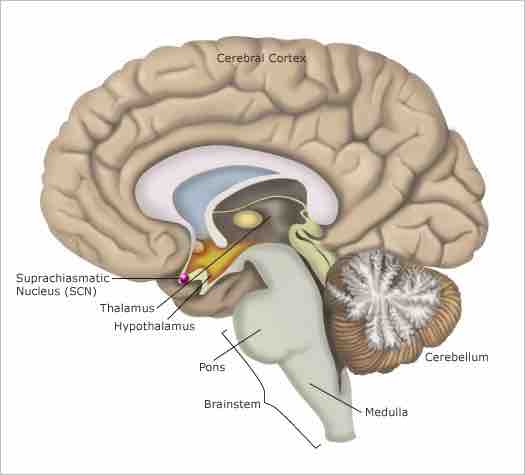Circadian rhythms are physical, mental, and behavioral changes that follow an approximate 24-hour cycle, responding primarily to light and darkness in an organism's environment. Circadian rhythms are found in most living things, including animals, plants, and many tiny microbes. These rhythms can influence sleep-wake cycles, hormone release, body temperature, and other important bodily functions. The study of circadian rhythms (and biological temporal rhythms in general) is called chronobiology.
Circadian Rhythms and the Suprachiasmatic Nucleus
Circadian rhythms are important in determining human sleep patterns. The body's master clock, or the suprachiasmatic nucleus (SCN), controls the production of melatonin, a hormone that makes you sleepy. The SCN is a small group of brain cells located in the hypothalamus that controls the circadian cycles and influences many physiological and behavioral rhythms occurring over a 24-hour period, including the sleep/wake cycle. The circadian pacemaker, located in the SCN, regulates the timing and consolidation of the sleep-wake cycle, while sleep-wake homeostasis governs the accumulation of sleep debt and sleep recovery. Destruction of the SCN results in the complete absence of a regular sleep-wake rhythm.

The suprachasmatic nucleus
The SCN contains about 20,000 nerve cells, and is located in the hypothalamus, above the optic nerves.
The Effect of Light on Circadian Rhythms
Circadian rhythms are maintained by individual organisms, and their length varies somewhat between individuals. Therefore, they must be reset, either continually or repeatedly, to synchronize with nature's cycle. In order to maintain synchronization (a.k.a. entrainment) to a 24-hour cycle, external factors must play some role; of these factors, light exposure to the eyes is the strongest.
The SCN receives information about light through the eyes. The retina of the eye contains photoreceptors (rods for seeing at night, and cones for distinguishing colors), which are used for conventional vision. But the retina also contains specialized ganglion cells, which are photosensitive and project directly to the SCN, where they help in the entrainment of this master circadian clock.
The mechanisms by which light affects entrainment are not yet fully known. However, studies have shown that timing of light exposure, the length of light exposure, and the intensity/wavelength of light all influence entrainment and circadian rhythms.
Circadian Rhythms and Sleep
Our internal circadian pacemakers regulate the timing and duration of sleepiness and wakefulness throughout the day. The circadian rhythm falls and rises at different times of the day; in fact, numerous studies have demonstrated that human circadian rhythms in many measures of performance and physiological activity actually have a 2-peak daily (circasemidian) pattern. A typical adult will experience the strongest desire to sleep in the pre-dawn hours (around 2:00 a.m. to 4:00 a.m.) and in the early afternoon (around 1:00 p.m. to 3:00 p.m.). This frame may be slightly different depending on whether you are a "morning person" or a "night person." The sleepiness we experience during these circadian dips will be less intense if we have had sufficient sleep, and more intense when we are sleep deprived. The circadian rhythm also causes us to feel more alert at certain points of the day, even if we have been awake for hours.

Circadian rhythms influence sleep
Circadian rhythms have a hand in determining when we are alert and when we become sleepy.
When we have been awake for an extended period of time, sleep-wake homeostasis tells us that the need for sleep is accumulating, and staying awake becomes more difficult.
Segmented Sleep
Segmented sleep, also known as interrupted or divided sleep, is a multiphasic sleep pattern in which two or more periods of sleep are punctuated by periods of wakefulness. Along with a nap at mid-day, it has been argued that this is the natural pattern of human sleep. In fact, some scientists believe that maintenance of this sleep pattern is important in regulating stress.
Roger Ekirch, a historian who has researched segmented sleep extensively, argues that segmented sleep was the dominant form of human sleep before the Industrial Revolution. Circadian rhythms, as we’ve just discussed, are heavily influenced by light. Ekirch suggests that it is due to the modern use of electric lighting (computers, cell phones, office lights) that most modern humans do not practice segmented sleep.
In one experiment on segmented sleep, researchers had eight healthy men confined to a room for fourteen hours of darkness every day for a month. At first the participants slept for about eleven hours, presumably making up for their sleep debt. After that the subjects began to sleep much as people in pre-industrial times did. They would sleep for about four hours, wake up for two to three hours, then go back to bed for another four hours. They also took about two hours to fall asleep. Together, these results imply that segmented sleep is indeed our natural sleep rhythm.